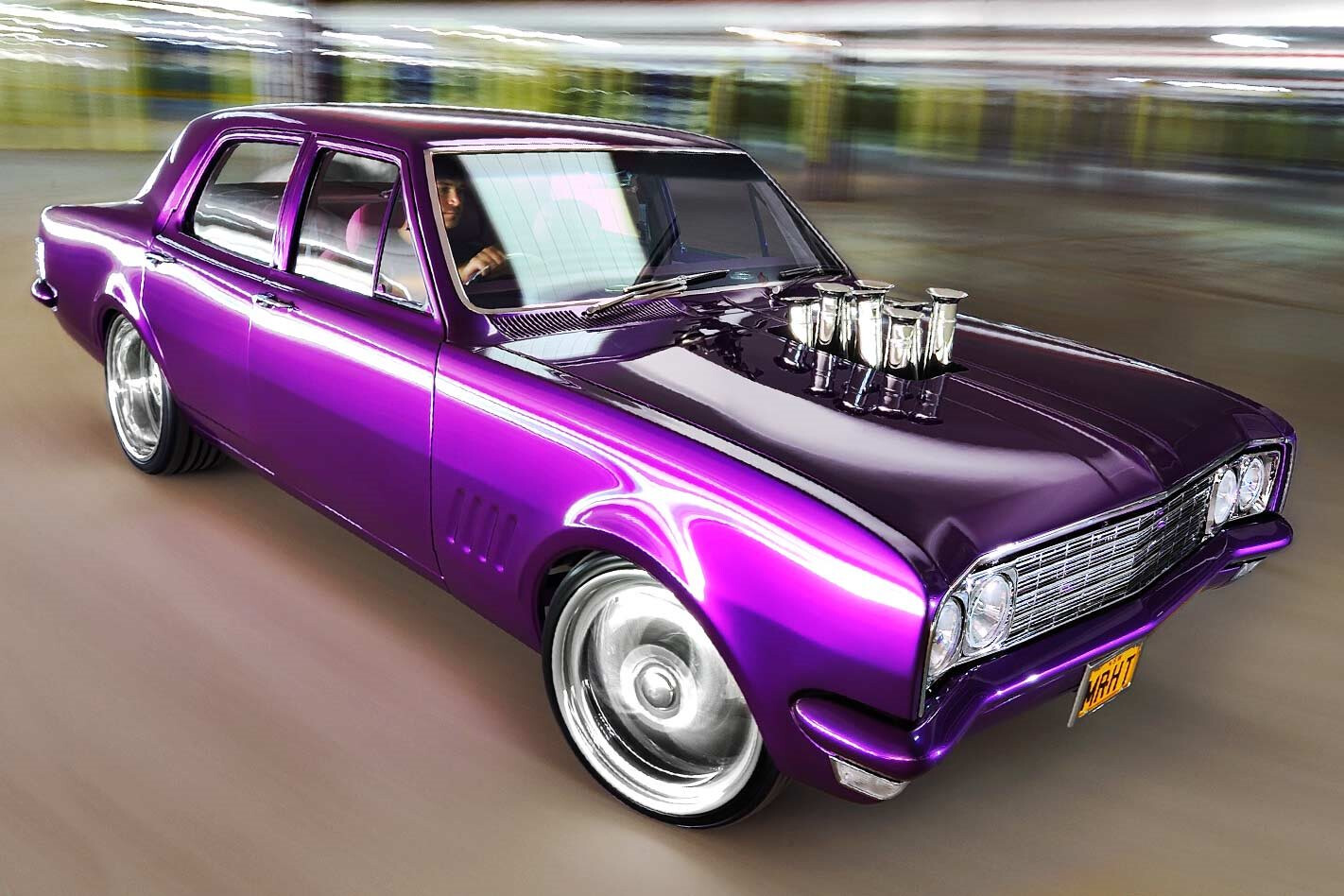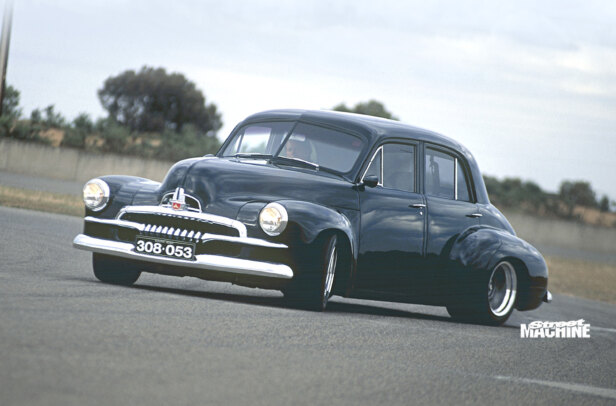This article on Colin’s HT Premier was originally published in the May 2010 issue of Street Machine magazine
A BLOKE by the name of Murphy once said if it can go wrong, it will go wrong. And if hard-luck stories such as Colin Sultana’s are anything to go by, Murphy must be a street machiner from way back.
Misfortune has plagued Colin’s superb MRHT Premier for years but instead of sour grapes, he reckons it’s just made the success he’s enjoyed with the car — since it was finished as dawn broke over Summernats 23 — all the sweeter.
“So many times I felt like giving up — coming back from the painters upset because nothing was getting done. It took seven years and six painters to get the car finished; it’s been a hard slog, and that’s why I’m so proud of it,” he says.
Before this build, the car was no paddock basher. It was neat enough to score Top Sedan and a spot in the Top 60 at Summernats in 2002, along with a feature in SM, Dec ’02.
“It won an Encouragement Award the following year,” Colin says. “The plan was to enjoy [the car] with my family but then it won about 20 trophies and I caught the show bug. I wanted to compete and to have a Top 10 show car.”
What the engine bay lacks in modifications it more than makes up for with fastidious detail work. Many alloy accessories were chromed rather than polished for ultimate impact
But in April 2003, old mate Murphy paid a visit in the shape of a rampaging Toyota LandCruiser, which smashed into the HT in traffic. Colin made the most of a dud situation, using it as an opportunity to strip the car to the metal and rebuild it as a show stopper.
It would be seven years before he’d yank the sheets off his creation before an appreciative audience at Summernats 23 and earn that Top 10 plate: “Aside from getting married and having my two little girls, it’s one of the highlights of my life. As a kid, growing up and reading mags, I dreamed of having my car on the cover of Street Machine.”
What sets MRHT apart from others on the show scene is that it’s not some extensively modified, over-engineered and impossible-to-register departure from its street-car roots. It is, in fact, a small-block, Chev-powered HT Holden with a Powerglide auto, and that combo was available from your friendly Holden dealer back in 1970. There’s no exotic engine transplant; no attention-grabbing, forced-induction set-up; no radical body mods or hand-fabricated chassis — just simplicity and the exquisite level of detail on offer.
The interior is a stand-out. Which you’d expect since Colin is a motor trimmer by trade. Plenty of thought and planning went into the HT cockpit, which, while extensively customised, is still based on the standard double bench-seat configuration.
“Owen Webb said to me: ‘Don’t turn up with a beige interior; try something different,’ so I did, and I came up with the lilac trim. Jason Lowe gave me a hand drawing and designing the interior, and my mate Dave helped out heaps. The idea to trim it in the same colour as the [exterior] came from the American scene. It’s a similar idea to Darryl McBeth’s FJ.”
VY Commodore buckets were seamlessly integrated into the front bench seat. It’s a unique look that combines the comfort and style of modern seats with the old-school charm of a front bench
Colin integrated VY Commodore bucket seats into the standard benches for that modernised CV8 Monaro look, and it works a treat. Like the rest of the interior, they’ve been wrapped in lilac cowskin, with purple snakeskin highlights. Flat floors feature darker purple inserts with polished alloy trims, a treatment which is carried over into the boot. The finishing touches are the billet accessories; from the Billet Specialties tiller mounted on a billet column, to the pedals, gauge surrounds, dash vents, scuff plates and B&M shifter, it’s all about forged alloy.
You could be excused for mistaking this for a CV8 Monaro rear seat at a glance. It is, however, another instance of new Commodore seats being installed into the stock bench
The exterior sea of luscious purple is similarly accented by shiny metal highlights — in the shape of 18x8in and 20x10in Intro V-Rod rims. The body mods were conducted by the first of six paint and panel shops that the car floated in and out of over the course of the build, with the gutters shaved, a flat firewall added, and some GTS flutes in the front guards. A sweet alloy beaver panel tidies up the rear end, while the body-coloured bumpers were a last-minute decision after Colin was let down … yet again.
The custom overhead console adds a hint of race car to the cabin but the real benefit is that it relocates unattractive ignition and accessory controls from the dash and column away from your line of sight
“The bumpers were sent to be chromed three months before Summernats and came back two weeks beforehand looking worse than when they went, so they had to be painted.” In the end, he found a bloke who didn’t give him the run around — Jason at Contagious Paint in Penrith.
A big part of the car’s attitude can be put down to those eight staggered trumpets that protrude through the bonnet. “I wanted something chrome out of the bonnet but I didn’t want to go a blower. I didn’t want two carbies or a hornet scoop, either,” Colin says. The Hillborn-based EFI inlet manifold tops a John Koolbanis-built solid-cammed 350 Chev, which has been specced for street performance against the time when Colin retires the car from the show circuit and hits the tarmac.
The beautifully detailed donk nestles in an environment where less is more: the brake booster shoved under the front guard; the wiper motor in the glove box and the battery in the boot. A flat firewall replaces the unsightly standard item, and the guards have been smoothed to perfection. Every component has been painstakingly detailed — the only item not purple, polished or chromed is the fan belt!
False floors and walls in the boot hide items such as the battery. Pattern on the boot walls and snakeskin inserts are carried over from the door trims. There’s still a huge usable space back there, for when the car is done on the show scene
It’s a similar story under the car: the braided brake and fuel lines were installed by Matt at Hi Tech Modifications, with almost every inch hidden from view. Suspension components such as springs and sway bars were painted, every nut and bolt was chromed, and the chassis and floorpan were smoothed and hand finished. Damien ‘Chubby’ Lowe helped guide the mods, keeping it clean and neat all the way.
Murphy had one more dig with some last-minute paint dramas, but the bonnet arrived in Canberra the night before the big Summernats unveil, and Colin was stoked to achieve so much on the car’s first outing.
“It was a dream come true. Aside from getting into the Top 10 and winning Top Sedan, it also got Third Top Paint, Third Top Interior, scored an invite to Meguiar’s Superstars, and won PPG Supreme,” he smiles. But for Summernats 24, he has his eyes on the big prize.
“I’m going for Grand Champion. I’m going to give it a real good shake — that’s my big aim. Then I’ll start … taking the family out for picnics and going on runs. My wife, Linda, and daughters, Celeste and Caitlin, have been awesome throughout the build. I want to enjoy the car with them.”
MECHANICAL OR ELECTRONIC
IT’S hard to beat the no-nonsense, balls-out visual appeal of a Hilborn mechanical injection set-up. The domain of drag cars, salt racers and the wildest Pro Street machines, mechanical injection is renowned for working brilliantly at wide-open throttle, and not particularly well anywhere else. But with an induction system like Colin’s, however, you can have your cake and eat it, too.
Cunningly, it’s a Hilborn mechanical injection manifold modified to accept electronic fuel injectors, so while MRHT retains the look of a mechanically injected car, it also boasts the reliability, drivability, tuneability and ease of starting of a modern electronically injected vehicle.
Injector bosses were welded into the manifold where the original mechanical injection nozzles once were. An EMS Stinger ECU runs both the fuel and ignition sides of the equation, receiving its crank-angle signal from the MSD distributor, and its throttle position information from a TPS switch mounted to the accelerator pedal, rather than the traditional spot on the throttle linkage, reducing engine-bay clutter and adding to that old-school appeal.
COLIN SULTANA
1970 HOLDEN HT PREMIER
Colour: PPG Custom Passion Pearl
ENGINE
Brand: Chev 350
Induction: Hilborn Injection converted to EFI
Heads: Chev Bowtie, Ferrea valves, Isky springs
Camshaft: Crow solid
Conrods: Chev X rods
Pistons: SRP
Crank: GM steel
Oil pump: Mellings
Sump: Hi Energy
ECU: EMS Stinger
Fuel pump: Bosch motorsport
Cooling: PWR alloy radiator
Exhaust: Custom four-into-one ceramic-coated headers
Ignition: MSD distributor
TRANSMISSION
Gearbox: Powerglide
Converter: 3000rpm TCE
Diff: Shortened 9in, 4.11:1, Moser axles
SUSPENSION & BRAKES
Springs: Lowered, painted (f), lowered leaves (r)
Shocks: Custom, painted (f&r)
Brakes: Cross-drilled rotors and ceramic-coated HQ calipers (f), HQ drums (r)
Master cylinder: Chromed, remote booster, hidden braided lines
INTERIOR
Seats: Modified bench seats (f&r)
Wheel: Billet Specialties
Mods: VY Commodore buckets moulded into f&r bench seats
Trim: Lilac leather
Instruments: Auto Meter
Shifter: B&M
Seatbelts: Lilac webbing
Stereo: In-dash DVD with 7in screen, Sony 6in front splits, Sony 6x9in rear speakers
WHEELS & TYRES
Rims: Intro V-Rod, 19×8 (f), 20×10 (r)
Rubber: Kumho 215/35/19 (f), 275/30/20 (r)




Comments